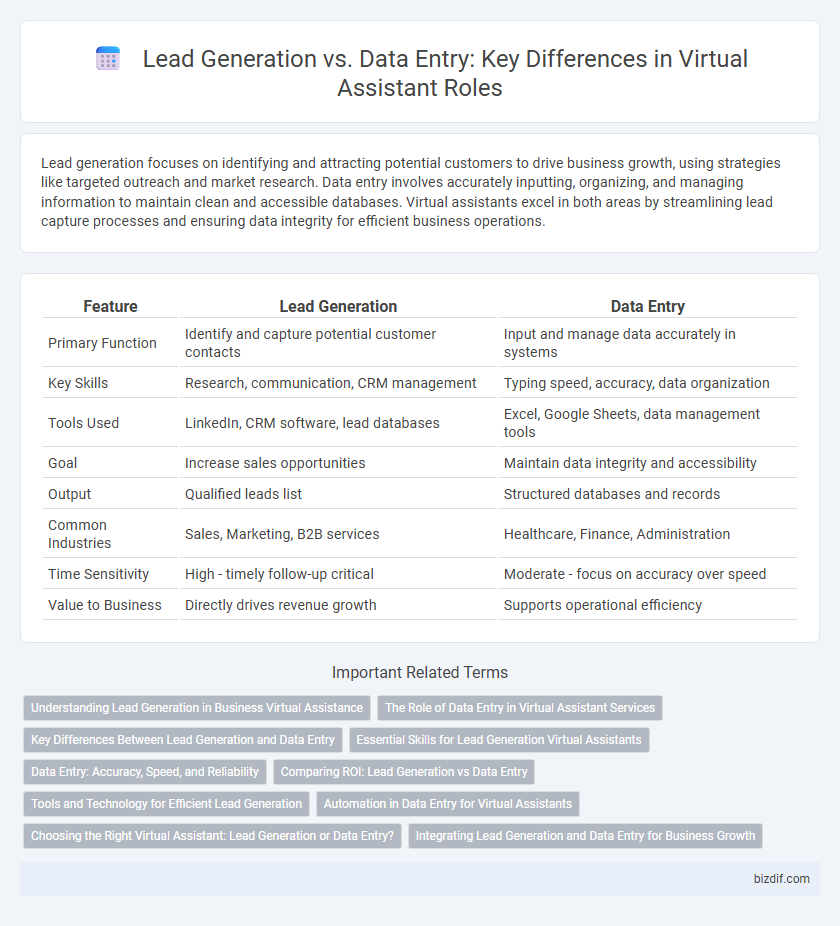Lead generation focuses on identifying and attracting potential customers to drive business growth, using strategies like targeted outreach and market research. Data entry involves accurately inputting, organizing, and managing information to maintain clean and accessible databases. Virtual assistants excel in both areas by streamlining lead capture processes and ensuring data integrity for efficient business operations.
Table of Comparison
| Feature | Lead Generation | Data Entry |
|---|---|---|
| Primary Function | Identify and capture potential customer contacts | Input and manage data accurately in systems |
| Key Skills | Research, communication, CRM management | Typing speed, accuracy, data organization |
| Tools Used | LinkedIn, CRM software, lead databases | Excel, Google Sheets, data management tools |
| Goal | Increase sales opportunities | Maintain data integrity and accessibility |
| Output | Qualified leads list | Structured databases and records |
| Common Industries | Sales, Marketing, B2B services | Healthcare, Finance, Administration |
| Time Sensitivity | High - timely follow-up critical | Moderate - focus on accuracy over speed |
| Value to Business | Directly drives revenue growth | Supports operational efficiency |
Understanding Lead Generation in Business Virtual Assistance
Lead generation in business virtual assistance involves identifying and nurturing potential customers to increase sales opportunities, whereas data entry focuses on accurately inputting and managing information. Effective lead generation requires skills in market research, customer profiling, and communication to qualify prospects and schedule follow-ups. Virtual assistants specializing in lead generation drive business growth by targeting high-conversion leads and maintaining CRM systems.
The Role of Data Entry in Virtual Assistant Services
Data entry plays a crucial role in virtual assistant services by ensuring accurate and organized information management that supports effective lead generation efforts. Virtual assistants handle data entry tasks such as inputting contact details, updating CRM systems, and maintaining databases, which enhances the quality and accessibility of lead data. Precise data entry allows businesses to streamline outreach strategies and improve conversion rates by leveraging well-structured lead information.
Key Differences Between Lead Generation and Data Entry
Lead generation involves identifying and attracting potential customers to drive business growth, focusing on strategic research, qualification, and engagement activities. Data entry centers on accurately inputting, updating, and managing information within databases or systems, emphasizing speed and precision. Key differences lie in their objectives: lead generation targets sales and marketing outcomes, while data entry supports operational efficiency and data management.
Essential Skills for Lead Generation Virtual Assistants
Lead generation virtual assistants excel in skills such as advanced research techniques, CRM management, and targeted outreach strategies to identify and engage potential clients effectively. Proficiency in data analysis and lead qualification ensures higher conversion rates by focusing efforts on high-quality prospects. Strong communication abilities and familiarity with automation tools enhance personalized follow-ups and streamline the lead nurturing process.
Data Entry: Accuracy, Speed, and Reliability
Data entry in virtual assistant services emphasizes accuracy, speed, and reliability to ensure precise handling of large volumes of information. Efficient data entry minimizes errors, supports timely updates, and enhances decision-making processes. Leveraging advanced tools and automation further optimizes data management and operational workflow.
Comparing ROI: Lead Generation vs Data Entry
Lead generation yields a higher return on investment (ROI) compared to data entry because it directly contributes to acquiring new customers and increasing sales revenue. While data entry primarily supports internal operations and improves data accuracy, lead generation actively drives business growth by generating qualified prospects. Companies investing in lead generation experience measurable improvements in conversion rates and long-term profitability, making it a more strategic choice for maximizing ROI.
Tools and Technology for Efficient Lead Generation
Efficient lead generation leverages advanced tools like CRM software, marketing automation platforms, and AI-powered analytics to identify and nurture potential clients, unlike traditional data entry which primarily involves manual input tasks. Technologies such as chatbots, predictive lead scoring, and integration with social media channels enhance lead targeting and conversion rates. Utilizing cloud-based systems ensures real-time data synchronization and streamlined workflows, maximizing productivity in lead generation efforts.
Automation in Data Entry for Virtual Assistants
Automation in data entry for virtual assistants significantly reduces manual input errors and accelerates workflow efficiency by utilizing AI-powered tools and software. Unlike lead generation, which requires personalized outreach and strategic engagement, automated data entry streamlines tasks such as customer information updates, invoice processing, and inventory management. This shift enables virtual assistants to focus on higher-value activities, enhancing overall productivity and accuracy.
Choosing the Right Virtual Assistant: Lead Generation or Data Entry?
Selecting the right virtual assistant depends on your business goals: lead generation specialists excel in identifying and engaging potential customers to boost sales pipelines, while data entry assistants focus on accurate and efficient management of large volumes of information. Prioritizing lead generation virtual assistants enhances marketing outreach and conversion rates, whereas data entry professionals improve data organization and operational accuracy. Assessing your immediate needs for customer acquisition or data management ensures optimized resource allocation and maximized productivity.
Integrating Lead Generation and Data Entry for Business Growth
Integrating lead generation and data entry optimizes customer acquisition strategies by ensuring accurate, real-time data management for targeted marketing. Automated synchronization between these functions reduces errors and accelerates the sales funnel, improving conversion rates. Streamlined workflows in CRM systems enhance business growth through efficient lead tracking and actionable insights.
Lead generation vs Data entry Infographic

 bizdif.com
bizdif.com